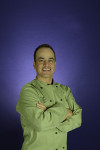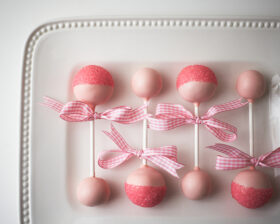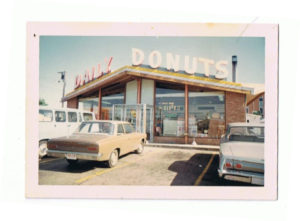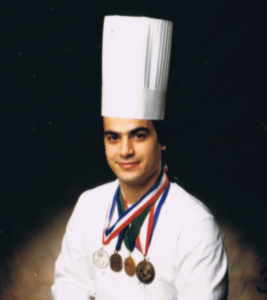Molding a Path to Success – Cake Decorating Molds
 by Terri Happi
by Terri Happi
As a chef, sculptor and cake decorating molds designer, Dominic Palazzolo has been innovating most of his life.
It’s a rainy April day and the street beyond the water speckled glass door is tranquil. Inside the Culinart building, the team laughs often, bustles with ideas and brainstorms furiously for ways to grant cake decorators’ wishes. Chef Dominic Palazzolo assesses the progress of a clay sculpture evolving into a new mold design, takes a call and then scurries back to the warehouse to check on production. The three separate businesses he operates under one roof keep him and his staff in a constant state of motion. A new line of molds is about to launch and the next few are in various stages of progress. There are still some technical issues to resolve, but Dominic is determined to experiment until he figures them out.
Starting when he first transformed bread into works of art, Dominic’s inventive ideas have taken many forms in a variety of media before they were realized in green silicone. Every day, the Marvelous Molds Facebook page is bombarded with beautiful cakes made by his customers, all thanking him for making their lives easier. Dominic understands what that truly means because he has painstakingly crafted many of his own masterpieces over the course of his career. As a chef, artist, inventor and entrepreneur, Dominic’s thirty years of innovating unfold into a truly fascinating story.
Born to a large Italian Catholic family in Cincinnati, Ohio, Dominic spent his childhood surrounded by his parents and eleven siblings. As an entrepreneur, his father was fortunate to raise a large staff right under his own roof. Although donuts were not a traditional Italian dessert, his father saw them as an opportunity and it just so happened he had a sweet tooth, too. At the time, there were no donut shops in Cincinnati; Dunkin Donuts was just starting out in other areas and flourishing, so Dominic’s father introduced a similar business model to the Cincinnati area. “’Give them 52 varieties of donuts and they will come,’ dad said,” Dominic recalls. And his father was right. Donuts became the hottest new thing and his business, Daily Donuts, grew into a chain of six stores.
As each child in the family approached the age of twelve, the time came to work in the family business making donuts. Dominic’s work experience began by sweeping the store lot, taking out garbage and folding boxes for donut dozens. At the age of fourteen, he moved up to the position of porter, cleaning the shop, mopping the floors, scrubbing the walls, filtering the fryer grease, and washing the windows and the large metal screens that held three dozen donuts at a time. Eventually, he was promoted to fryer and was responsible for frying all the donuts. If donuts needed glazing, he glazed them all. By the time he was 16, he was running the production shift and had graduated to the top position of baker. In the busy season, he was cranking out 750 dozen donuts by hand each day. Until the age of 19, Dominic and a crew of two men made the dough, proofed it and then cut and fried it before the donuts were passed on to the girls to finish them. He worked the day shift and his brothers worked the night shift.
Each night, all six donut shops made donuts, but that wasn’t enough. Dominic’s father, in an effort to always have a fresh and complete selection, made donuts twice a day, the second time to replenish the supply to the satellite stores by truck.
The Wake-up Call
“In my family there was no pressure to do well in school, only great consequences if you failed. I just got by,” Dominic confesses.
Dominic’s attitude towards school and direction in life took a 180 degree turn following a terrible car accident. “My head went through the windshield. I thought I was going to die. I had that moment when time stops. The accident gave me the realization that life is very precious. It was the kick in the pants I needed to find my own motivation. The middle child in a big family only cares about not being beat up by older brothers and dealing with younger siblings. It’s a numb, stupid ignorance. The accident made me become an individual,” he recalls.
Dominic’s awakening led to a greater interest in schoolwork, straight A’s and making the dean’s list. He developed a love of science and physics that lured him to pursue pre-medicine in college. After a year of study, he realized that becoming a doctor would mean spending his time in offices and hospitals treating sick people. “I just liked the science of it and I didn’t think that was a good enough motivation to be caring for people.” He considered veterinary medicine as an alternative, but at that time, it was not a preferred field to pursue. Ultimately, he decided he would just go back to working for his father full-time.
Around the time Dominic began attending college, donuts had started popping up in grocery stores. It was a time of transition when new businesses were beginning to offer more specialized items. His father had enjoyed a long run monopolizing the donut business through the golden years when the only donuts one could buy in a supermarket were the Hostess variety and bakeries offered donuts as a side item. As a means to continue flourishing, Dominic’s father wanted to expand to include gourmet ice creams, soups and sandwiches. In order to satisfy that need, Dominic entered culinary school.
Dominic was an exceptional student throughout his tenure at the Culinary Institute of America. He and some of his classmates traveled to compete at the New York Hotel and Restaurant Show representing the school against the likes of Johnson and Wales students where they won numerous gold medals. He was highly adept at working with pastillage, marzipan and pulled sugar, welcoming any type of challenge that came his way.
“When I went to the CIA, it was the first time that it occurred to me that I had some skills. I could do things other people couldn’t. That gave me a whole lot of confidence,” he says.
As Dominic progressed to advanced baking and pastry classes, students would be invited to attend large buffets where his class would present their original centerpiece ideas. Dominic decided he wanted to create a woven basket from pastillage, but his idea required the approval of the chef. ‘“The chef said don’t do it because it’s extremely difficult. You’re just a student and you’re setting yourself up for failure,’” Dominic recalls.
As it turned out, it was one of his greatest centerpieces. He had figured out how to tame quickly drying pastillage in order to weave it, create a handle and adorn it with flowers made from marzipan. “Pulled sugar and piping borders in royal icing came the same way. Cooking sugar with almonds, rolling it into sheets, cutting it and forming it into shapes came very naturally. I received a tremendous amount of attention from the top chefs at the Culinary Institute when they saw what I could do.”
In 1979, he graduated at the top of his class as the most outstanding student. The teachers were polled to determine who would be chosen to receive a scholarship to continue studies at the institute for a three month period as a teacher’s assistant. Consequently, Dominic was selected for intensive training in baking and pastry arts. Although the scholarship was intended to be either an a.m. or p.m. shift, Dominic chose to do both every day. “I wanted to get the most out of it and continue to represent the Culinary Institute in competitions,” he says. It was an opportunity to work with celebrity chefs from Europe, many of whom had received their citizenship and shifted to teaching because they were tired of working in the kitchen. “I would pick their brains and get a lot of extra attention that other students never received.” When his scholarship was complete, many companies were interested in hiring him.
Following his extensive culinary training, Dominic had anticipated holding a better position when returning to the donut shop, but found that the economy had changed and his father’s business did not expand in the direction that was planned. That’s when he decided it was time to find his own path. Shortly thereafter, he married his wife, Julie, and considered his next career move.
Off and Baking
Upon graduation, Dominic received many employment offers, but was drawn to a pastry department position at the Fairmont Bellevue Stratford Hotel in Philadelphia for its unique opportunity to work alongside master chef Gunther Heiland, a multi-gold medal winner at the Culinary Olympics.
It was a grand hotel that had been completely gutted and refurbished following its closing that resulted from the breakout of the Legionnaire’s disease. Fairmont hosted grand productions, catering to thousands of people at a time.
“There wasn’t any type of pastry I shied away from. If someone wanted a pomegranate sorbet for a party of 1200, I would say no problem. If they wanted a pulled sugar basket with flowers, I was happy to oblige. I could make a serving tray cast in chocolate holding an impressive array of chocolate truffles. While I had experience in many different areas, I would say my specialty has always been making centerpieces – a nougat sculpture, a pulled sugar centerpiece, bread sculptures and pastillage pièce montées. I could take almonds cooked in browned sugar and roll it out on a slab and create a nougat basket garnished with sugar bows and ribbons. I could do this with my eyes closed,” Dominic says.
Once the hotel staff witnessed Dominic’s extraordinary centerpiece creations, they became a necessary element on the Fairmont buffet table. But much of his time was consumed creating desserts for the restaurant and banquets. The realization of how repetitive and temporary in nature his daily creations were began to set in and he longed to create more permanent art forms. “I really started to be attracted to centerpiece work that would be used over and over again until it needed to be replaced,” Dominic comments.
By that time, Dominic had won a grand championship in Philadelphia representing the hotel and taken home several medals of his own. While he had received a very attractive offer to be the Executive Pastry Chef at the Royal Sonesta Hotel in New Orleans, he didn’t want to spend his career constantly moving and working in that type of environment.
Back to Cincinnati
Upon his return home, Dominic accepted a position as the Plant Manager at Kosterman’s Bakery. His responsibilities entailed hiring staff and developing bread formulas to create fancy bread, pastries and croissants to supply restaurants in Ohio, Kentucky and Indiana. Several years later, he decided there really was something about creating food that was unappealing to him. “Somewhere around this time, I only started to realize I was creative. While I was creating things that were very artistic, people were eating them and then the art was gone,” he said.
Rise of Bread Effects
Dominic was feeling limited by hotel standards and systems. Whenever he created a bread sculpture, “People would lose their minds over it. At every place I ever worked, once they found out I could do this type of artistic work, they had to have it. They never needed it until they saw me do it.”
Confident he could monetize his unique talents, Dominic set out on his first lone venture in 1984 when he opened The Bread Effects Company offering hand-crafted baskets and cornucopias sculpted from bread. Yet, a harsh reality set in; his pa
ssion for bread sculpting alone could not pay the bills and his business almost went under. But, a trip to the National Restaurant Show changed everything.
In a pick-up truck loaded with his products, he headed to the show and set up his bread centerpieces. He was down to his last $100 with a wife and two young children at home. Luckily, attendees, which included the Marriott, Hyatt and Drake Hotels, bought his centerpieces.
From that moment on, the Bread Effects Company was off and running. Dominic was supplying centerpieces to the White House, Waldorf Astoria, Plaza Hotel and sheiks in Saudi Arabia. His was the only business of its kind. “You would think I could make a million dollars, but even back then, they thought my work was expensive.”
Dominic’s bread work:
(Before creating cake decorating molds) Up until 1998, Dominic provided his hand-crafted bread masterpieces to hotels, restaurants, country clubs and cruise lines all over the world. But running a business that required such a specialized skill made things difficult and expansion impossible.
“You have to have a God given talent to do art with bread. If you don’t know what you’re doing, you’ll get lost in the difficulty of it. I designed a pneumatic extruder that would push out long ropes of dough, creating pliable strands that were ideal for weaving into baskets. I realized it was so hard to find people to train. I saw it as an unsustainable business model because I couldn’t delegate to other people. I could charge $1000 per basket but no one would pay it. I could only make as much as I could physically produce myself. I realized I needed to get myself into something else. That’s when I took an interest in tallow,” he explains.
The Turn to Tallow
Chefs had been using tallow to sculpt buffet centerpieces for over 300 years, but its tendency to turn rancid eventually led the Board of Health to deem it unacceptable. Dominic thought that if he could formulate a tallow mixture that wouldn’t go bad, he could restore the medium to its former popularity. In 1996, he set off on a mission to find the perfect combination of ingredients to accomplish just that. He came across sterile animal fat which, by itself, had a one year shelf life. By combining it with wax, a natural retardant, he invented a tallow that would last forever.
“My formula also had superior modelling and sculpting characteristics. It was especially successful with cruise lines. They had been carving cheese and, after a week, it would have to be discarded. They asked me to make tallow the color of cheddar cheese. That ended up on the buffets. They asked for it in chocolate. I figured it out. I sold chocolate, white, cheddar and butter. Then there were people who didn’t know how to make a sculpture and wanted to buy a completed sculpture out of the box,” Dominic says.
“I hired a consultant and he taught me everything about mold making. I took to it like I was a sculptor and mold maker in a previous life. I understood everything about it, read every book I could get my hands on and started making my own molds to pour my tallow into. I would make a mermaid sitting on a rock or an eagle catching a salmon in a stream. As I learned mold making, I understood the great advantages that molds offered. Ninety percent of everything is made with a mold. Most of the parts that make a car, your coffee maker, kitchen sink, jewelry, shoes, everything is molded. Why? Because you create a perfect design, then you can capture it permanently in a mold and the mold will reproduce your design over and over and over,” he explains.
Dominic’s tallow sculptures were so well received by chefs throughout North America, Europe and the Caribbean Islands that he made the decision to swap the art of bread making for tallow manufacture and sculpting and changed the name of his company to Culinart, Inc. He offered over 100 competition quality showpieces for sale on the company website in the customer’s choice of tallow. All had been cast in the molds he made from his originals.
Despite the convenience of replicating his work with molds, he found the work to be labor intensive. He was servicing a small subset of the culinary industry; his target market comprised a mere five percent of operations in the country because of the price point. That realization led him in a new direction.
Dominic’s tallow work:
Make Your Own Molds
In 1993, Dominic founded Make Your Own Molds supplying easy-to-use food-grade mold making materials to chefs.
“When I understood the advantages of molds, I thought about how amazing it would be if a chef could have all the advantages of making molds in a kitchen. I had to make it easy for them or they wouldn’t want to do it,” says Dominic.
Once again, Dominic was back to innovating — only this time he was experimenting with silicone materials. At the time, mold making materials on the market had mixing ratios that were too complicated for a chef to work with; scaling out ten parts base to one part catalyst was too difficult to do, especially when a chef just wanted to make a small, two ounce batch for a little mold.
“If I told the chef half and half, no measuring would be required; he understood it immediately. I was one of the first in the nation to come out with one-to-one food-grade silicone that was easy enough for anyone to use. It was possible to make anything with Silicone Plastique and in one and a half hours you’ve got a mold,” he added.
Dominic’s videos popularized his mold making techniques and eventually landed him a double segment on the Martha Stewart Show where he demonstrated the process of making lollipops.
Then one day, he received a call from Hall of Fame sugar artist, Kerry Vincent. She was in the midst of writing her book “Romantic Wedding Cakes” and interested in creating a mold to decorate one of her cakes. “I had no idea there was room in the sugar art industry for my products until I got a call from Kerry Vincent. I was trained as a pastry chef, not in sugar arts. When Kerry Vincent enlightened me about the cake industry, she inspired me to make a pivotal move in my career and I’ve never looked back,” Dominic recalls.
Meanwhile, Dominic’s tallow business was growing and he was ordering a lot of wax. (possible callout: One day, the wax representative came into Dominic’s office, saw his sculptures and told him, “If you put a wick in that, it would be a candle. People would go crazy if you made that into a candle.”
The representative went on to depict the candle industry as a multi-billion dollar industry. Enthusiastic about the idea, Dominic proceeded to create luminarias, which are a type of open vessel, glowing candle.
Ablaze Candles
In 1996, following two years of experimentation to perfect the burning qualities of his candles, Dominic started Ablaze Candles applying his artistic tallow sculpting techniques to candle making. He had invented a type of wax that was hard, shiny and a beautiful, ivory color to use as the exterior of the candle. The outside of the candle featured one of three hundred different sculpted designs. The interior was coated with a clear layer of paraffin. When the flame was lit, the clear paraffin acted as a conductor, backlighting the outer layer. Within the candle, a smaller votive created an ethereal glow, and because the outer, sculpted candle was never burned, the candles could last a lifetime. The product line featured everything from flowers to wildlife to architecture.
“When you lit the candle inside, it glowed twice as much as a wick directly in a candle. You could see them a block away. I developed a religious following for Ablaze Candles, sold only online. But they were not cheap. Some were $90 and some as large as a garbage can. I had a four foot clam shell illuminated by four votive candles that would light up an entire deck at night.”
Again, Dominic was appealing to the upper echelon. His clients included princesses in Arabia and emirates in Iran who would stockpile his candle designs. But, by the end of 2008, the economy had taken a downfall. “The only people who would make it in that economy were funeral parlors and toilet paper manufacturers. Other than that, many small businesses were closing their doors. I knew the day was coming when I would be out of business, so I made a film about my company in an effort to find prospective buyers and eventually sold it. It was enough to carry me through the hard times of 2007 – 2008 and it enabled me to start Marvelous Molds.”
Marvelous Molds
In 2010, Dominic started manufacturing his signature green molds under the Marvelous Molds brand.
“I watched cake decorators struggle to form decorations in a standard, block mold. They had to continuously press the fondant down into the mold, and then, once it was unmolded, the edges of the decoration still needed to be trimmed. To me it seemed too labor intensive, and I felt the mold should be doing the work to make the cake decorator’s life easier. That’s when I started thinking about the concept of a blade cutting along the edges of the design to cleanly trim the cake decoration,” Dominic comments.
In his usual, pioneering fashion, Dominic set out to design molds better than they’d ever been made before. “When we came out with the bladed mold, the reaction to it was mind blowing. This type of product acceptance was something I had never experienced before,” he recalls.
Marvelous Molds’ bladed molds were first introduced at the San Diego ICES Convention. “As soon as I demonstrated it, everybody got it. It was amazing to experience the excitement when your invention is well received by your customers,” says Dominic.
Marvelous molds:
Applying the new blade mold technology, Dominic teamed up with renowned cake artist Earlene Moore to create a line of lace molds. Cake decorators couldn’t get their hands on the beautiful designs fast enough. Their success led to collaborations with Marina Sousa, Elisa Strauss and James Rosselle a few years later.
Two years passed when a cake shop owner approached Dominic to tell him how cumbersome it was to work with plastic stencils, indicating he should come up with a way to apply designs to a cake using molds.
“That’s the idea that started the process of looking for a way to transfer a design to a cake. It couldn’t be a regular mold. We began by putting a mold up against a cake and had to figure out why it didn’t work. Then we thought about removing the body of the mold and using blades configured to create a transfer. I rolled out clay, carved grooves to create a design and made a rough mold over that. I sheeted fondant and put it over the mold. Then I wet it and put it on the cake. To my surprise, it worked. We just continued to refine the design and the type of silicone used,” says Dominic.
When the Silicone Onlays debuted, the response was far greater than it had been with the bladed mold. For the first time, cake decorators were able to sheet fondant, use a Silicone Onlay and apply a design perfectly on a cake. “It’s impossible to do this perfectly by hand using cutters. The Onlay enables anyone to do the impossible and it doesn’t matter what your skill level is. All you have to do is go through the learning curve of using an Onlay and then you can transfer these designs to a cake. It transports you to a new level of ability. The bladed mold was a national phenomenon. The Silicone Onlays were a worldwide phenomenon. When you are lucky enough to come up with a new product that works and people like it, you can’t make them fast enough, you can’t do anything fast enough because the whole world wants it right now. All my life, with bread baskets, tallow sculptures, candles, mold making materials and even the bladed molds, I’ve never experienced anything like that before nor did I expect to. It was a lot of fun, but the hardest I’d ever worked. Being at an ICES Convention with my Onlays will always be one of those big events in my life where I experienced something absolutely unforgettable,” Dominic shares.
In 2012, Dominic won the Sweet Life Award at the National Capital Area Cake Show in Fairfax, Virginia. Founded by Norman R. Davis and Zane Beg of Norm & Zane The Sweet Life, LLC, the award recognized an exemplary cake industry vendor who had made significant contributions to facilitate cake artists and provide innovative products to the marketplace.
During a recent visit to Carlos’ Bakery, Dominic spent time catching up with “Cake Boss” Buddy Valastro and spent the morning instructing his staff how to work with the latest mold designs. Buddy expressed to Dominic that his molds had “set a higher standard of mold making… that make us better cake decorators.”
“I don’t make molds of palm trees, baby shoes or ducks. I would rather create molds that can be used to decorate any type of cake. I create stunning borders, swags and appliques because they save the decorator time, speed up production and ultimately save the cake decorator money while producing consistent results. Our designers create every mold design by hand. We put a great deal of effort into every mold to ensure they will help decorators make beautiful cakes,” Dominic says.
Dominic currently holds three patents from the United States Patent and Trademark Office and has two more on the way. Prior to the invention of the cutting blade, he performed research to see if the idea had been previously conceived by someone else. To his surprise, no one had thought of it. A global patent search disclosed the same results. In 2010, Dominic applied for the cutting blade patent and it was finally granted this year. “The invention was so simple that the U.S. government could not believe that no one had ever thought of this before and so they spent a long time researching before they would grant me the patent,” Dominic comments.
“Later in life, I finally realized I am an inventor. I never considered myself an inventor, but now that I have had these experiences, I think once again I have found out something new about myself. New inventions are always in the back of my mind and I’m perpetually reconfiguring them until I come up with a solution,” he says.
“In all the marketplaces I have supplied, I have never known a finer group of people, more loyal customers or been surrounded by such nice people. They appreciate what I do, encourage me, inspire me and make me feel like what I’m doing is important. You can’t find that among most trades in the world. The cake industry is a grouping of the kindest people on Earth and to that I owe my success,” Dominic shares.
To learn more about Dominic’s extensive line of cake decorating molds made of silicone, visit MarvelousMolds.com. His mold making materials can be found at MakeYourOwnMolds.com. Dominic continues to offer tallow through tallowcarving.com as the only distributor of tallow in the world.
Buy this issue here:
 Many thanks to Shawna McGreevy of McGreevy Cakes for allowing us to publish her amazing 9 Ladies Dancing cake as part of this article.
Many thanks to Shawna McGreevy of McGreevy Cakes for allowing us to publish her amazing 9 Ladies Dancing cake as part of this article.
If you would like to view a tutorial for this cake please visit http://mcgreevycakes.com/9-ladies-dancing-sparkly-bow-tutorial/.
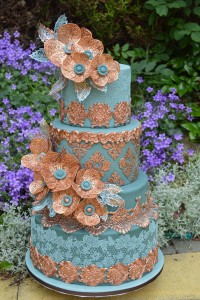 We would also like to thank Clair Bowman of The Cake Decorating Company for sharing her amazing cake too!
We would also like to thank Clair Bowman of The Cake Decorating Company for sharing her amazing cake too!
Theresa Happe is the Executive Editor, Edible Artists Network; Director of Marketing, Marvelous Molds; and author of CakesWeBake.com and www.cake-decorating-corner.com.

